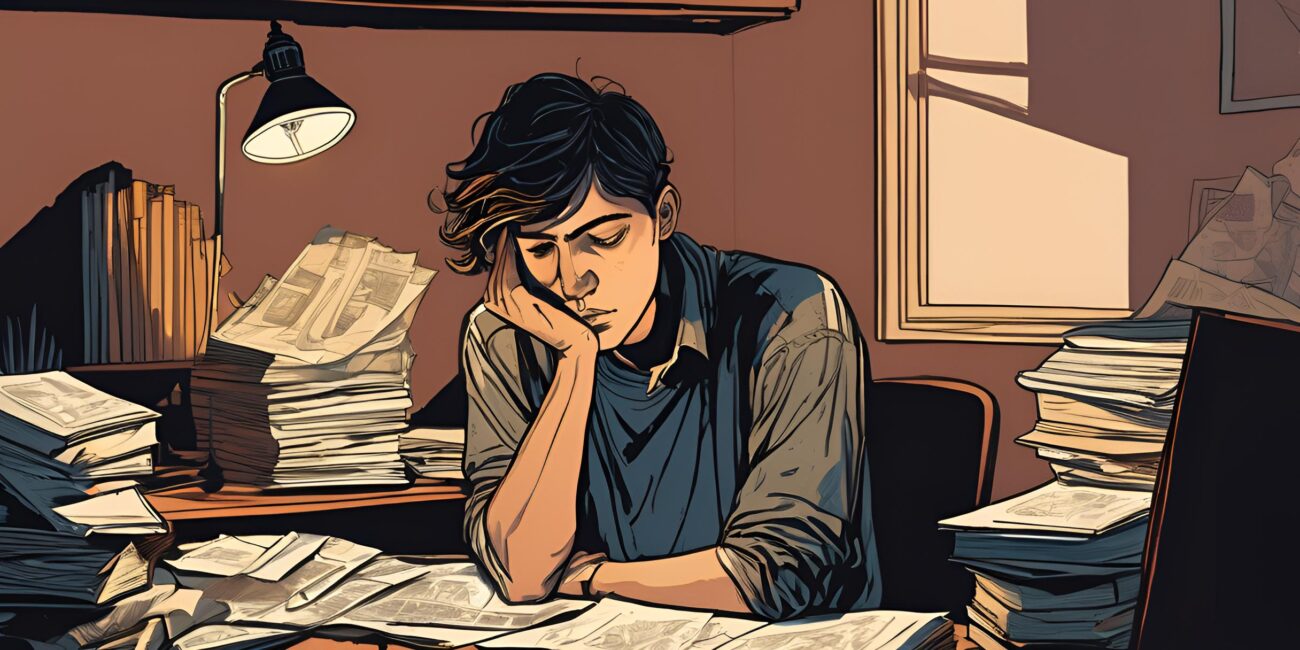Putting Down the Red Pen: How to Know When to Stop Editing

It’s easy to get caught up in tweaking one more sentence. Knowing when to stop editing a manuscript, an article, or a short story is probably one of the most challenging aspects of any piece of writing or editing. The document is often pried from white-knuckled grips with the faint hope of yet another extension.
This desire for perfection leads to a sort of editorial paralysis. On the one hand, you can’t move forward until you’re satisfied with the placement of every period and semicolon. The hard truth is that you’ll probably never be satisfied. That’s natural. No one wants to put out bad work. Unfortunately, on the other hand, getting caught in the endless cycle of editing means not putting out any work at all. So, when should you put down the red pen?
Table of Contents
Getting to Grips with the Editing Process
One of the reasons why it’s so easy to get caught up in the editing process is that it’s complex and lengthy. The various types of editing are all focused on making the project as perfect as possible, so it’s no surprise that editors get stuck in. Just consider these examples:
- Structural editing: This type of editing looks at the overall structural integrity of writing, focusing on coherency, consistency, and clarity on a large scale.
- Line editing: This editing process also deals with consistency, but on a line-by-line basis (hence the name). It checks for confusing sentences, inconsistent dialogue, and continuity errors. At this point, editors can start overediting, tweaking away, and overthinking every word placement.
- Proofreading: Often the final stage in the editing process, proofreading is the last coat of polish. It attempts to rectify any remaining language and formatting mistakes.
All of these processes take time and effort. Editing is probably one of the most difficult aspects of writing – if not the most difficult – but it’s necessary to make writing as clear as possible.
What is Editor Paralysis?
There’s a (paraphrased) quote floating around on the internet from the French poet Paul Valéry: “A work is never finished, only abandoned.” What happens when you can’t abandon it, though? When you’re stuck trying to make sure it’ll make every single reader happy and every grammar nazi solute? That’s when the paralysis sets in.
Editor paralysis (similar to writer’s block) is basically a fear response to imperfect work. You might not even know you’re afflicted until deadlines start looming and the manuscript is still not quite there. (Procrastination is a common symptom.)
You’ll probably find yourself playing the comparison game too. The internet makes that so easy. Some of the world’s greatest and most edited writings, all just one click away. Never mind that you’re editing an article on the best cat litter brands; look at that article for Icelandic fjords. It’s so readable and smooth – the comments are great. Maybe you should restructure the litter brand article for the seventh time?
Down the Rabbit Hole: 5 Signs of Overediting

1. The Revision Loop Trap
Yes, what if you changed this, that, or changed it back? Was it better before? If you find yourself stuck in a similar loop – making changes, reverting, and then making changes again – you’ve stumbled upon one of the first signs.
2. Word Choice Paralysis
It’s easy to hyper-focus on word choice, all while forgetting that a reader will probably spend nothing more than a split-second reading it. They aren’t obsessed with what words you choose. They’re there for the larger manuscript experience. As long as they receive that smoothly, there’s little value for you in burning the midnight oil with the thesaurus.
3. Structural Shuffling Without Purpose
Moving around sentences, paragraphs, and sections? Ask yourself if it’s bringing value to the work. If it doesn’t impact the flow of the manuscript, there’s very little reason to shuffle around puzzle pieces when the picture is already there. If there’s no method to the madness, you might end up creating issues where there weren’t any to begin with.
4. Declining Confidence
A decline in confidence (in yourself and your manuscript) is all too common when overediting. The more you edit, the more you see the minuscule cracks in the project – stuff that most readers don’t even notice. You’ll end up looking at the project under a microscope, doubting your choices, and becoming unhappy with chapters that you thought were finished.
5. Project Deadline Creep
Stereotypically, wordsmiths are some of the worst procrastinators. They miss deadlines and request extensions until they have no choice but to let it go. Ironically, perfectionism isn’t practical, especially when there are business aspects to consider. That’s why knowing when to stop editing and take a step forward is so important.
How to Know When It’s Time to Stop Editing

Recognise Diminishing Returns in Your Edits
Editing is a lot like an archaeological dig site. Editors chisel, hammer, and brush away all the dirt from a manuscript to reveal the hidden object beneath. When you start to edit, you’ll have a lot to do – but the more you pick away, the less dirt will remain. Eventually, if you keep at it, you’ll start to damage the very thing you were trying to salvage.
That’s why we agree with author Ronel Janse van Vuuren, who recommends planned editing to get out of an editing loop:
- Start with the big picture (i.e. developmental/structural edits)
- Work your way down to the nitty-gritty (i.e. from individual scenes to eagle-eyed language edits)
Editing without a plan (or any kind of order) will lead to frustration and wasted time.
Set Editing Goals and Stick to Them
Building on the previous point, having a plan is good. However, you also need to execute it successfully. This means setting a realistic goal for each editing task. Without this guideline, you may just step back into the overediting trap. Alternatively, trying to do too much in too short of a timeframe can lead to anxiety and subpar work.
So, how do you find your sweet spot? Try these tips from a Reddit forum:
- Use a tracking tool like Toggl to determine your average editing time for different tasks.
- Implement the Pomodoro technique for bursts of focused work.
- Take a break after writing before starting the editing process.
Remember, you need to set editing goals that work for you. Some editors work on a minimum word count, others dedicate X hours per day, while another batch edits a set number of chapters.
Set a Firm Deadline to Wrap Up
Why set a deadline in the first place? Parkinson’s Law. It reigns true, now more so than ever. What does it say? Simply put, your work will expand to fill the amount of time you have to finish it. Have an essay due in a week? It’ll probably take you a week to write it. A novel in three months? Guess how much time you’re likely to spend on it.
Setting a deadline and sticking to it helps you let go when it’s time. It also helps you inch forward and resist the urge to go back and obsess over the inconsequential things. Just remember, be realistic about them.
Anne Janzer provides good advice on balancing deadlines:
- Set deadlines that are achievable but motivating. It shouldn’t be so flexible that you eventually ignore it, but it shouldn’t be so tight that it damages your work quality and mental health.
-
- Don’t set a final, imposing deadline only. Break it up into smaller parts so you can systematically reach your goal. For example, by [date X], my structural edits will be done. By [date X], my language edits will be done. And so on.
Use a Checklist for Final Edits
Another good way to avoid overediting is to use a checklist of things in a manuscript that need to be completed and examined. This allows you to approach it in a structured way and have a good idea when it’s time to stop editing. Unsure of where to start with a checklist? Here’s an example for a fiction manuscript:
Language and Visuals
Chapters, Paragraphs, and Sentences
- Are they organised logically?
- Does it feel like they are building on one another?
- Do they transition smoothly from one to the other?
- Are all word choices consistent with the manuscript and genre?
- Are all words and sentence constructions understandable in context?
Spelling and Grammar
- Are lexical features consistent throughout?
- Does the manuscript pass an editing software check?
- Is punctuation used consistently throughout the manuscript?
Visuals
- Are images supplied where necessary?
- Are they formatted correctly?
Facts and Consistency
Characters and Dialogue
- Do characters behave realistically?
- Does dialogue remain consistent for each character?
- Are character motivations established and maintained?
- Are character descriptions consistent?
Worldbuilding
- Are historical facts and dates validated where necessary?
- Does the story remain consistent with what has been established in the manuscript?
- Are there any unexplained flaws in logic?
Plot and Pacing
- Is there an identifiable beginning, middle, and end?
- Does the plot move forward coherently?
- Is pacing and voice steady throughout the manuscript?
Remember, this is only an example of a checklist. It may not apply to your project, but should give you a good idea of how to draw up your own. Alternatively, you can also view:
- An online editing checklist for blogs and website copy
- An online editing checklist for academic work
Get a Second Opinion
Another way to overcome overediting is to put it in someone else’s hands. It’s invaluable to have a trusted party examine your work. This can be a colleague or another editor. They can tell you if your fears of imperfection are grounded or unfounded. We often look too long at a project and don’t know what’s good or bad anymore. In cases like this, we tend to see it all as bad.
Fresh eyes are the key, even your own. So, if you don’t have any peers to turn to immediately, put the project aside and return to it later. A short break can give you the distance you need to try again.
Overcoming Perfectionism in the Editing Process
As we’ve established already, fears of imperfection are often the root cause of editor paralysis. Overcoming word-related perfection isn’t a snap once and go. It’ll take time. More than that, it’ll probably be a painful process. Our advice?
- Accept that you can’t please everyone.
- Know that sometimes good enough really is just that.
- You become a better writer and editor with each project you complete.
- Trust yourself and the publisher’s standards.
Many people struggle with this, so you’re not alone. Fortunately, others have faced and conquered similar challenges, offering valuable lessons to learn from. A great starting point is Jennifer Louden’s tips on overcoming fear and perfectionism in writing. The key is rewiring your brain to stop fearing imperfections:
- Do breathing exercises to help yourself focus and stay calm.
- Write down ‘what if’ situations to get negative thoughts out of your head.
- List your writing fears in a journal and cross them off as you defeat them.
Breaking the Cycle: When to Stop Editing and Release Your Work

Letting go of a piece of work is never easy, but it’s a necessary step in the creative process. The key to knowing when to stop editing lies in trusting your instincts, setting clear boundaries, and accepting that perfection is an illusion.
Your work doesn’t have to be flawless to resonate – it just needs to be authentic. So, loosen your grasp a little, accept that your control can only go so far, and allow the project to move forward by learning how to stop editing when you need to.

Blue Leaf Team
The Blue Leaf Editing team has over 15 years of combined editing, publishing, and book industry experience. We’re passionate about content and storytelling, and sharing our knowledge with others.
info@blueleafediting.com